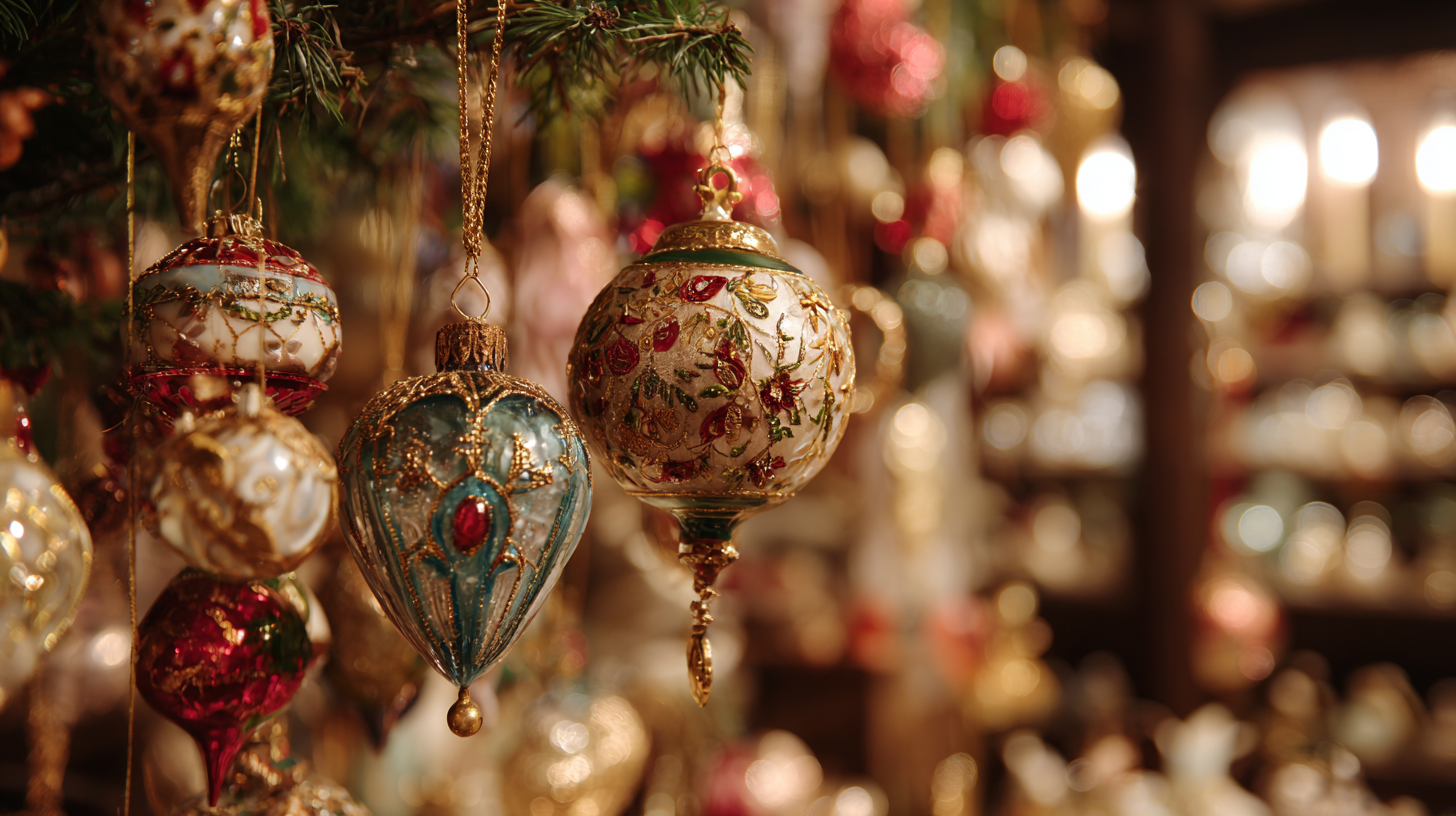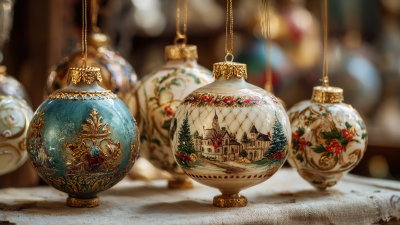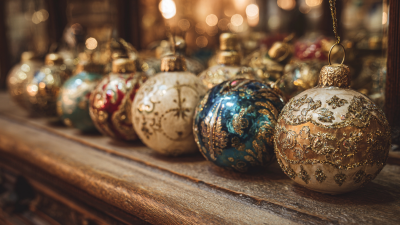The holiday season is a time of warmth, joy, and cherished traditions, and one of the most delightful aspects of this festive period is the decoration of our homes. Among the myriad of holiday decor, Antique Christmas Ornaments hold a special allure, capturing the nostalgia and craftsmanship of eras gone by. These exquisite pieces not only serve as beautiful decorations but also act as windows into the past, reflecting the cultural and artistic influences of their time. In this guide, we will embark on a journey through the history of Antique Christmas Ornaments, exploring their evolution, significance, and the stories they tell. Whether you are an avid collector or just beginning to appreciate the charm of vintage holiday decor, this exploration will unveil the enchantment of these ornaments and inspire you to incorporate a touch of history into your own holiday celebrations.

Antique Christmas ornaments have a rich history that reflects the evolution of holiday decor across various periods. The earliest known ornaments date back to the 19th century, featuring intricate glass designs that originated in Germany. According to a report by the National Christmas Tree Association, approximately 23% of American households display vintage ornaments, showcasing a sustained interest in these historical decor pieces. During the Victorian era, ornaments became more accessible, with mass production techniques allowing for a wider audience. This led to the introduction of colorful, hand-blown glass ornaments that would quickly become beloved staples of holiday decor.
As the 20th century progressed, the style and materials used in Christmas ornaments evolved significantly. The introduction of tinsel and aluminum allowed for more dazzling displays, and the first commercially made ornaments were manufactured in the United States in the 1930s. Data from the Antique Glass Ornament Collector's Club indicates that these ornaments, especially those produced before World War II, are highly sought after by collectors today, with some fetching prices upwards of several thousand dollars at auction. This period marked a significant shift in the aesthetics of Christmas decoration, embracing not only religious themes but also whimsical designs that resonated with a more secular celebration of the holiday season.
| Period | Key Features | Materials Used | Popular Ornament Types |
|---|---|---|---|
| 19th Century | Handcrafted glass ornaments and elaborate designs. | Blown glass, metal, wood. | Glass baubles, figures, and animal shapes. |
| Early 20th Century | Introduction of mass production and bright colors. | Tin, mercury glass. | Shiny brite ornaments, tinsel garlands. |
| Mid 20th Century | Innovative designs with unique colors and themes. | Plastic, glass. | Character and novelty ornaments, whimsical shapes. |
| Late 20th Century | Focus on artisanal and handcrafted ornaments. | Recycled materials, fabric. | Handmade wooden ornaments, eco-friendly designs. |
Antique Christmas ornaments carry a unique charm, showcasing the rich history of holiday decor. When exploring these time-honored decorations, it’s essential to understand the materials used, as they significantly influence both aesthetic appeal and market value. The most commonly found materials include glass, metal, wood, paper, and fabric. Each material tells its own story, reflecting the craftsmanship and artistic trends of its era.
Tips for collectors: When seeking antique ornaments, pay attention to glass varieties. Hand-blown glass ornaments often fetch higher prices due to their intricacies. Additionally, vintage metal ornaments, especially those from the mid-20th century, are prized for their durability and nostalgic designs. Always check for signs of wear, as well-preserved pieces retain their value much better than those that are damaged or excessively worn.
Understanding the historical context of these materials can enhance your appreciation for each piece. For instance, wooden ornaments were commonly made during the Victorian era, while paper decorations gained popularity in the 20th century. When choosing ornaments for your collection, consider not only their beauty but also their potential as investment pieces as some vintage decorations continue to increase in value over time.
 Antique Christmas ornaments not only bring a sense of nostalgia but also serve as a mirror reflecting the cultural trends of different eras. From the delicate glass baubles of the Victorian era to the playful, mass-produced designs of the mid-20th century, these ornaments showcase the evolving tastes and societal influences on holiday decor. According to the American Christmas Tree Association, 94% of Americans decorate their homes for the holidays, and many appreciate the historical significance and craftsmanship found in antique pieces. Collectors often seek ornaments that tell a story about their origins and the period they represent, making each ornament a tangible connection to the past.
Antique Christmas ornaments not only bring a sense of nostalgia but also serve as a mirror reflecting the cultural trends of different eras. From the delicate glass baubles of the Victorian era to the playful, mass-produced designs of the mid-20th century, these ornaments showcase the evolving tastes and societal influences on holiday decor. According to the American Christmas Tree Association, 94% of Americans decorate their homes for the holidays, and many appreciate the historical significance and craftsmanship found in antique pieces. Collectors often seek ornaments that tell a story about their origins and the period they represent, making each ornament a tangible connection to the past.
Popular themes observed in antique Christmas ornaments also highlight shifts in societal values and aesthetics. For instance, during the Great Depression, ornaments became more utilitarian, with families creating homemade decorations from available materials, illustrating resilience and creativity. Conversely, the post-war boom brought an influx of colorful, manufactured ornaments, reflecting a society eager to celebrate prosperity and abundance. According to a report by the Antique Trader, interest in vintage holiday decor has surged in recent years, with collectors actively seeking ornaments that embody these historical narratives, thereby fostering an appreciation for the intricate craftsmanship and cultural significance woven through the fabric of holiday traditions.
Caring for antique Christmas ornaments requires a gentle touch and an understanding of their unique materials and craftsmanship. Many of these cherished items are made from fragile materials such as glass, metal, or delicate fabrics, and improper handling can lead to irreversible damage. To ensure their longevity, store them in a cool, dry place, away from direct sunlight, which can cause fading and deterioration. When packing them away, use acid-free tissue paper or bubble wrap to cushion each ornament, making sure to separate them to prevent scratches and breakage.
Cleaning antique decorations is another crucial aspect of their maintenance. Avoid harsh chemicals that can strip the finish or harm delicate surfaces. Instead, use a soft cloth slightly dampened with water or a gentle soap solution to carefully wipe away dust. For items with intricate designs or embellishments, a soft brush can help reach crevices without causing harm.
Lastly, regularly inspect your ornaments for signs of wear or damage, addressing any issues promptly to preserve their beauty and history. By following these guidelines, you can maintain the charm of your antique Christmas ornaments for generations to come.
The market for vintage holiday décor, particularly antique Christmas ornaments, has seen a noteworthy resurgence in recent years. Collectors and enthusiasts are increasingly drawn to the unique craftsmanship and history behind these items, which often tell a story of bygone eras. These ornaments, ranging from glass baubles to handmade decorations, not only evoke nostalgia but also serve as investment pieces. As demand grows, the value of rare and well-preserved ornaments can appreciate significantly, making them a viable consideration for savvy collectors.

Understanding the market value of these vintage pieces requires a keen eye for authenticity and historical significance. Factors such as age, condition, and rarity play crucial roles in determining an ornament's price. For instance, mid-century American ornaments, especially those produced by artisans or well-known companies, often command higher prices at auctions and specialty shops. Additionally, documentation, such as the original packaging or provenance, can further enhance an ornament's appeal and value.
As the holiday season approaches, both collectors and investors should pay close attention to emerging trends to make informed decisions that celebrate the charm of antique decorations while also potentially yielding financial rewards.






